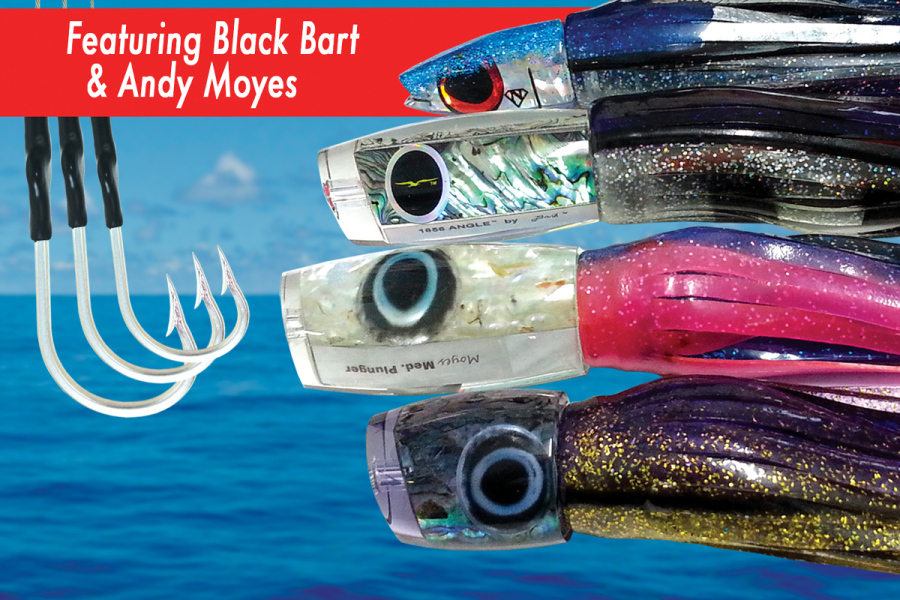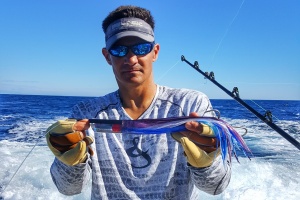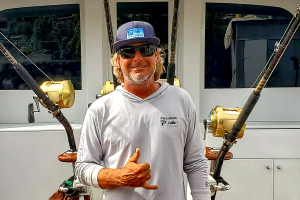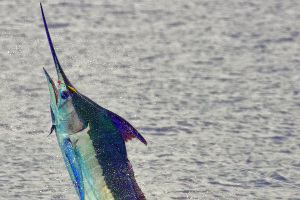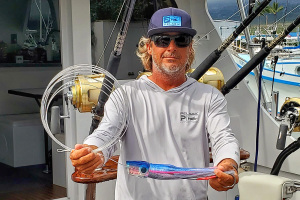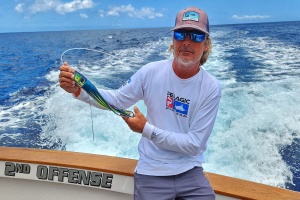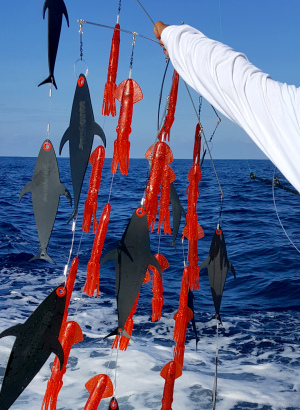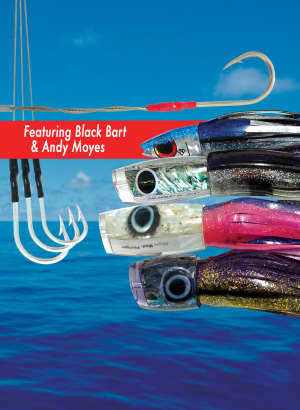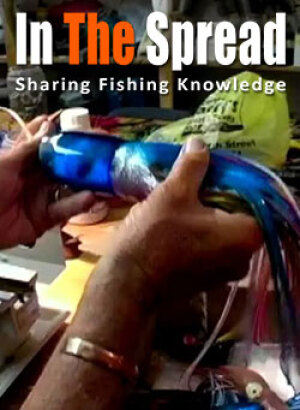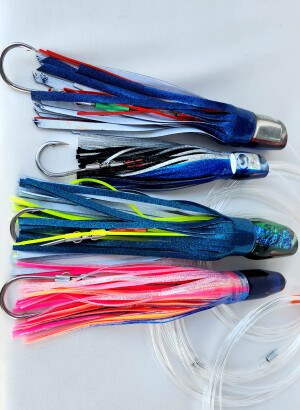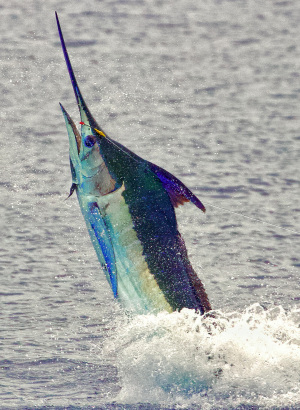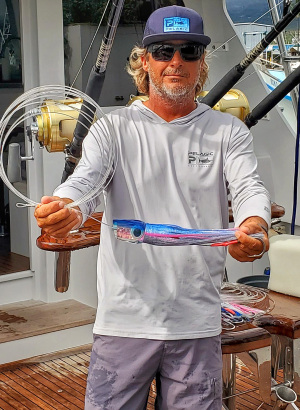The blue marlin, Makaira nigricans, is a large oceanic fish species with a distinctive elongated body and sharp bill. It belongs to the Istiophoridae family and is known for its metallic blue dorsal side and silvery white underbelly. Known for its large size and high value for sport fishing, it is considered a delicacy in many countries.
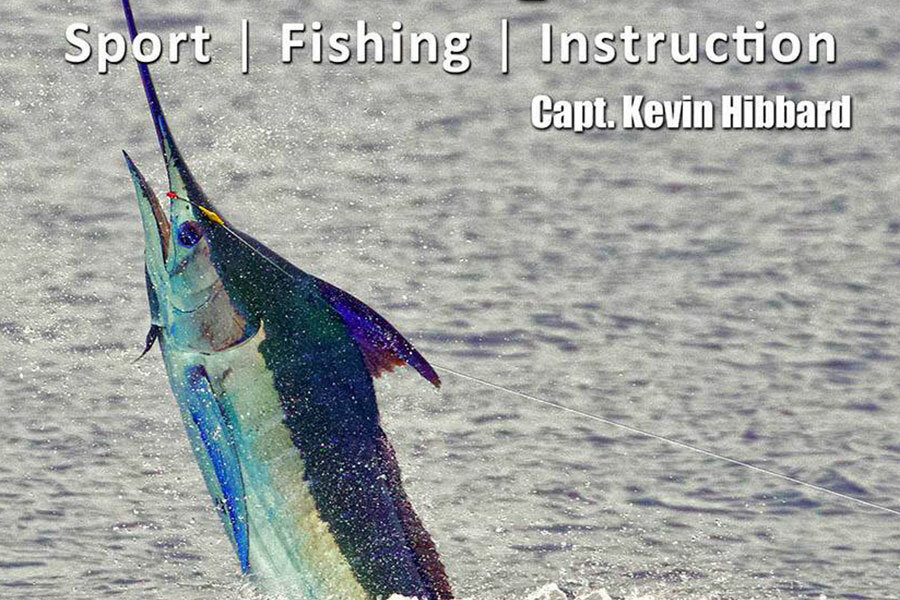
Blue Marlin – The Ultimate Game Fish
The blue marlin, Makaira nigricans, is a large, oceanic fish species with a distinctive elongated body and a sharp, pointed bill. Its scientific name is Makaira nigricans, and it belongs to the family Istiophoridae, which includes other billfish such as sailfish and swordfish.
Here's the taxonomy of the blue marlin:
- Kingdom: Animalia
- Phylum: Chordata
- Class: Actinopterygii
- Order: Perciformes
- Family: Istiophoridae
- Genus: Makaira
- Species: Makaira nigricans
Blue marlins are characterized by their metallic blue dorsal side and silvery white underbelly. They are known to inhabit tropical and subtropical waters worldwide, often found in the open ocean and near the surface. They can grow up to 14 feet in length and weigh over 1,500 pounds, making them one of the largest fish species in the world. They are highly valued for sport fishing and their meat is considered a delicacy in many countries.
Learn fishing tactics and techniques for blue marlin with these instructional videos https://inthespread.com/marlin-fishing-videos
Blue Marlin Fishing Techniques
Distinguishing Characteristics
The blue marlin has several distinguishing features that set it apart from other fish species:
- Elongated body: The blue marlin has a long, streamlined body that is adapted for fast swimming and hunting.
- Sharp bill: The blue marlin's upper jaw is elongated and forms a sharp, pointed bill, which it uses for hunting and defense.
- Deeply forked caudal fin: The blue marlin's tail, or caudal fin, is deeply forked, which gives it excellent maneuverability and speed in the water.
- Metallic blue coloration: The blue marlin's dorsal side is a distinctive metallic blue color, which fades to a lighter shade on its sides. Its underbelly is silvery white.
- Size and weight: Blue marlin are one of the largest bony fish species in the world, with adults reaching lengths of up to 14 feet and weights of over 1,500 pounds.
- Highly specialized predator: The blue marlin is a highly specialized predator, with several adaptations that make it a formidable hunter in the open ocean, such as its sharp bill, speed, and agility.
Overall, the blue marlin's distinctive body shape, coloration, and highly specialized predatory adaptations make it a unique and recognizable species in the world of fish.
Body Color
The blue marlin is known for its vibrant and distinctive coloration. Its dorsal side is a metallic blue color that fades into a lighter shade on its sides, and its underbelly is a silvery white color. The blue coloration on the dorsal side is thought to provide camouflage from above, as it blends in with the color of the ocean when viewed from above. Additionally, the blue marlin's color can change depending on its mood, with the blue becoming brighter and more intense during aggressive or excited behavior. Overall, the blue marlin's striking coloration is one of its most notable and recognizable features.
Body Weight and Size
Blue marlins are known to be one of the largest species of bony fishes in the world, with a remarkable size and weight range from juveniles to adults.
Juvenile blue marlins typically range in size from about 1 to 4 feet (0.3 to 1.2 meters) and weigh between 10 and 200 pounds (4.5 to 90 kg). At this stage, they are often preyed upon by larger fish and marine mammals.
As they mature, blue marlins can grow up to enormous sizes. Adult blue marlins can reach lengths of up to 14 feet (4.3 meters) and weigh over 1,500 pounds (680 kg). However, the average size of an adult blue marlin is closer to 11 feet (3.4 meters) and weighs around 200 to 400 pounds (90 to 180 kg).
The growth rate of blue marlin is influenced by factors such as water temperature, food availability, and genetics. They have been known to grow rapidly, reaching a length of over 6 feet (1.8 meters) within the first year of their life. Overall, the size and weight of a blue marlin can vary greatly depending on its age, sex, and environmental conditions.
Mouth
The blue marlin has a distinctive, elongated upper jaw that forms a sharp, pointed bill, or rostrum. This bill is used for hunting and defense, allowing the blue marlin to slash through schools of prey fish with remarkable speed and agility. The lower jaw of the blue marlin is relatively small in comparison to the upper jaw and has small sharp file like teeth that are used to capture and hold onto prey.
The blue marlin's bill is a highly specialized tool that is used for hunting and has several unique adaptations. The bill is covered in sensory organs called ampullae of Lorenzini, which can detect the electrical signals produced by the movement of prey fish in the water. Additionally, the bill is highly maneuverable and can be used to change direction quickly, making the blue marlin a highly effective predator.
Overall, the blue marlin's distinctive mouth and bill are essential features that allow it to hunt and survive in its oceanic habitat.
Speed
The blue marlin is known to be one of the fastest fish in the ocean and can swim at remarkable speeds to catch its prey. Blue marlins have been known to reach speeds of up to 60 miles per hour (97 kilometers per hour), although typical swimming speeds are closer to 20 to 30 miles per hour (32 to 48 kilometers per hour).
This incredible speed allows the blue marlin to pursue and catch a wide range of prey, including smaller fish, squid, and even larger prey like tuna and swordfish. When hunting, blue marlins will often use their sharp bill to slash through schools of fish, stunning or killing them, and then circle back to consume their prey. They are also known to use their speed to outswim and tire out larger prey, such as tuna, before attacking and feeding on them.
Overall, the blue marlin's remarkable speed and agility make it a highly effective predator and allow it to catch a wide range of prey in its oceanic habitat.
Caudal Fin
The tail, or caudal fin, of the blue marlin is a powerful and distinctive feature that plays an important role in its swimming and hunting abilities. The blue marlin's caudal fin is deeply forked, which helps to increase its maneuverability and speed in the water. The upper and lower lobes of the fin are relatively long and pointed, giving the blue marlin a sleek and aerodynamic shape.
The caudal fin of the blue marlin is made up of strong muscles and connective tissue, allowing it to generate a tremendous amount of propulsion as it swims. This propulsion is critical for the blue marlin's fast swimming speeds and allows it to pursue and catch its prey with incredible agility.
Overall, the tail of the blue marlin is a highly specialized and important feature that plays a key role in its survival and success as a predator in the open ocean.
Sporting Quality
The blue marlin is considered one of the most highly prized and sought-after game fish in the world, making it a popular target for recreational fishermen. Blue marlin are known for their incredible strength, speed, and agility, making them a thrilling catch for experienced anglers.
When hooked, blue marlin are known to put up a fierce fight, often leaping out of the water and making long, powerful runs. The challenge of landing a blue marlin, combined with their impressive size and beauty, makes them a favorite among sport fishermen.
In many areas, blue marlin are caught and released to conserve their populations, with anglers taking measurements, photographs, and DNA samples before releasing them back into the water. This practice has helped to protect the species and ensure that future generations can continue to enjoy the thrill of catching blue marlin.
Overall, the blue marlin's sporting qualities, combined with its size, beauty, and cultural significance, have made it a highly prized target for recreational fishermen around the world.
Predatory Instincts
The blue marlin is a highly specialized predator, with several adaptations that make it a formidable hunter in the open ocean. One of the most distinctive features of the blue marlin is its long, sharp bill, which it uses to slash through schools of prey fish, stunning or killing them, and then circling back to feed on them. The bill is also used for defense, allowing the blue marlin to fend off potential predators.
In addition to its bill, the blue marlin is known for its incredible speed and agility, which allows it to pursue and catch a wide range of prey, including smaller fish, squid, and even larger prey like tuna and swordfish. The blue marlin is also known for its endurance, often using its speed and strength to tire out larger prey before attacking and feeding on them.
Blue marlins are known to be opportunistic feeders and will often prey on whatever is abundant in their habitat. They have been observed feeding on everything from squid and small fish to larger prey like tuna and swordfish. They are also known to be voracious feeders, consuming up to 5% of their body weight each day.
The predatory instincts of the blue marlin are finely tuned and highly specialized, allowing it to thrive as a top predator in the open ocean.
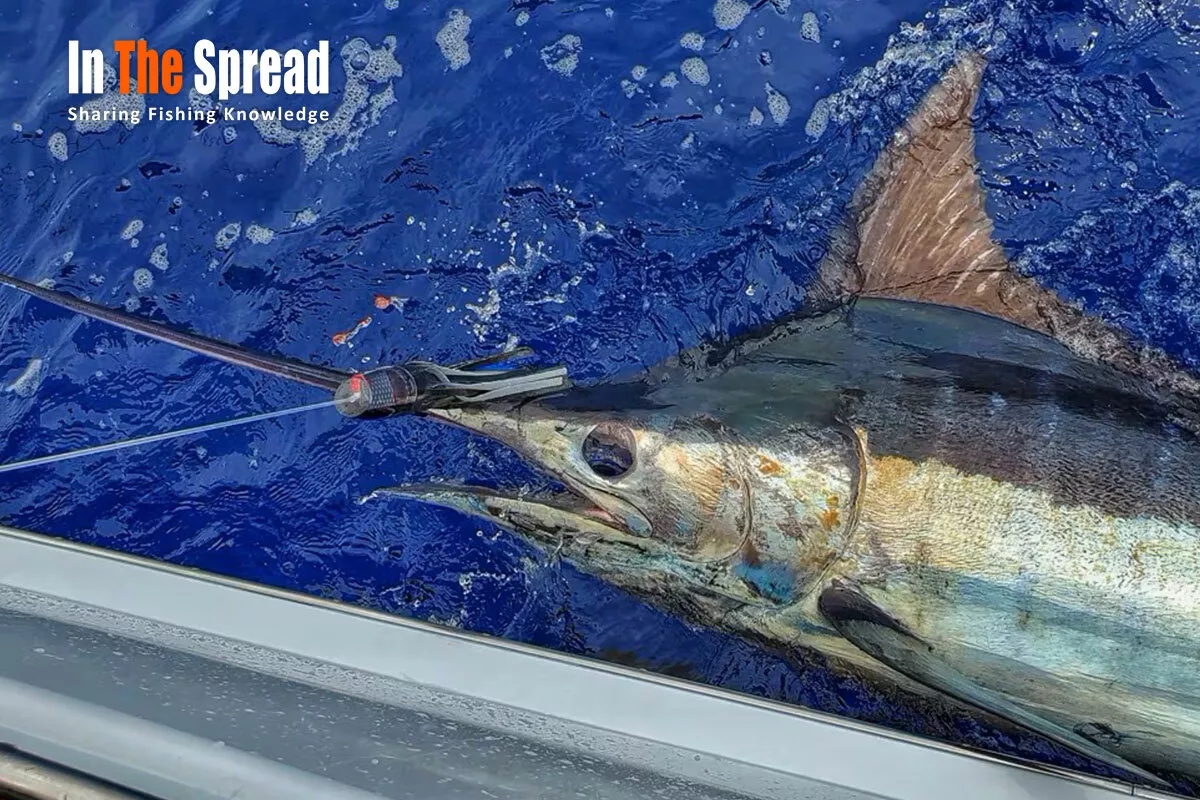
Habitat
The blue marlin is a highly migratory fish species that is found in tropical and subtropical waters worldwide. They are typically found in offshore waters, often far from land, and are commonly associated with warm ocean currents and underwater structures such as seamounts, canyons, and ridges.
Blues prefer water temperatures between 72 and 84 degrees Fahrenheit (22 to 29 degrees Celsius) and are often found in waters with a depth of at least 100 meters (328 feet). They are known to inhabit both the Atlantic and Pacific Oceans, as well as the Indian Ocean and the Mediterranean Sea.
In addition to their offshore habitats, blue marlins are known to make regular seasonal migrations between their feeding and spawning grounds. During these migrations, they may travel thousands of miles, crossing entire oceans and following major ocean currents.
A blue marlin's habitat is vast and varied, encompassing large parts of the world's tropical and subtropical oceans.
Distribution
Blue marlins are found in tropical and subtropical waters around the world, in both the Atlantic and Pacific Oceans, as well as the Indian Ocean and the Mediterranean Sea. They have a circumglobal distribution, meaning they can be found in all the major ocean basins of the world.
In the Atlantic Ocean, blue marlins are found from the Gulf of Mexico and the Caribbean Sea to the eastern coast of South America and as far north as Newfoundland. They are also found in the western Atlantic, from the coast of Brazil to the eastern coast of the United States.
In the Pacific Ocean, blue marlins are found from the coast of California to Chile, as well as in the waters around Hawaii and in the western Pacific, from Japan to Australia. They are also found in the Indian Ocean, particularly in the waters around Mauritius and the Seychelles.
Blue marlins are a highly migratory species and are known to make seasonal migrations between their feeding and spawning grounds. During these migrations, they may travel thousands of miles, crossing entire oceans and following major ocean currents.
The distribution of blue marlins is vast and spans a wide range of tropical and subtropical waters around the world.
Blue Marlin Diet
The blue marlin is a highly predatory fish species, and its diet is diverse, consisting of a wide range of prey species. Blue marlins are opportunistic feeders, meaning they will consume whatever is abundant and available in their habitat. Some of the most common prey species for blue marlins include:
- Small fish: Blue marlins will feed on a variety of small fish species, including dolphins, mackerel, tuna, squid, and flying fish.
- Squid and octopus: Blue marlins are also known to feed on squid and octopus, which are abundant in their offshore habitats.
- Crustaceans: Blue marlins will occasionally feed on crustaceans such as shrimp and crab.
The blue marlin's predatory instincts are highly specialized, and it is adapted for fast swimming and maneuvering in the water. Its sharp bill and powerful caudal fin allow it to quickly pursue and catch its prey. Overall, the blue marlin's diet is diverse and adaptable, allowing it to thrive in a variety of oceanic habitats.
When and Where to Fish for Blues
Blue marlin fishing is a popular activity around the world, and there are many destinations known for their abundant blue marlin populations. Here are some of the best places to fish for blue marlin and the best time of year for each destination:
- Kona, Hawaii: Kona is known for its abundant blue marlin population, and the best time to fish for blue marlin here is from June to September. Capt. Kevin Hibbard shares his experience and wisdom on blue marlin fishing Kona in this educational fishing video https://inthespread.com/marlin-fishing-kevin-hibbard-kona
- Cape Verde: Cape Verde is located off the coast of West Africa and is known for its world-class blue marlin fishing. The best time to fish for blue marlin in Cape Verde is from June to October.
- Costa Rica: Costa Rica is known for its abundant billfish populations, including blue marlin. The best time to fish for blue marlin in Costa Rica is from December to April.
- Azores: The Azores, an archipelago located in the Atlantic Ocean, is a popular destination for blue marlin fishing. The best time to fish for blue marlin in the Azores is from June to October.
- Cabo San Lucas, Mexico: Cabo San Lucas is a popular destination for sport fishing, including blue marlin fishing. The best time to fish for blue marlin in Cabo San Lucas is from May to September.
- Bahamas: The Bahamas is known for its world-class blue marlin fishing, and the best time to fish for blue marlin here is from April to June.
The best time of year to fish for blue marlin can vary depending on the destination and local weather patterns. It is always recommended to consult with local fishing guides and experts to determine the best time and location for blue marlin fishing.
Effective Fishing Tips
Blue marlin fishing can be a thrilling and challenging experience, but it requires skill and patience. Here are some effective blue marlin fishing tips to help increase your chances of success:
- Choose the right location: Blue marlins are found in tropical and subtropical waters around the world, and it is important to choose a location with a high concentration of blue marlin.
- Use the right gear: Blue marlin are powerful fish, and it is important to use heavy-duty fishing gear, such as a 80- to 130-pound test line, a sturdy rod, and a large reel with a high line capacity.
- Use live bait: Blue marlin are known to be attracted to live bait, such as mackerel or tuna. Use live bait rigged with a circle hook and a wire leader.
- Troll at the right speed: Blue marlin are fast-swimming fish, and it is important to troll at a speed of at least 7 knots. Use lures or baits that mimic the blue marlin's natural prey, such as squid or flying fish.
- Watch for signs of activity: Look for signs of activity, such as feeding birds or jumping fish, which can indicate the presence of blue marlin.
- Be patient: Blue marlin fishing can require hours or even days of waiting, so be patient and stay focused on the task at hand.
- Release responsibly: If you catch a blue marlin, it is important to handle it carefully and release it back into the water as quickly as possible to minimize harm to the fish.
Blue marlin fishing requires skill, patience, and a deep understanding of the fish and its habitat. By following these tips, you can increase your chances of success and enjoy a thrilling and rewarding fishing experience.
For a broad spectrum of blue marlin fishing knowledge and know-how, watch these videos featuring several of the best marlin fishermen in the world:
Fishing Gear
- Small Blue Marlin:
- Rod: For small blue marlin, a heavy-duty spinning rod or conventional rod with a length of 6 to 7 feet and a line rating of 50 to 80 pounds is suitable.
- Reel: A high-quality spinning reel or conventional reel with a line capacity of at least 400 yards of 50-pound test line is recommended. Look for a reel with a high gear ratio to quickly retrieve line.
- Line: A braided line with a strength of at least 50 to 80 pounds is recommended for small blue marlin.
- Big Blue Marlin:
- Rod: For big blue marlin, a heavy-duty conventional rod with a length of 7 to 9 feet and a line rating of 80 to 130 pounds is recommended.
- Reel: A high-quality conventional reel with a line capacity of at least 500 yards of 80-pound test line is recommended. Look for a reel with a strong drag system and a high gear ratio for quick retrieves.
- Line: A braided line with a strength of at least 80 to 130 pounds is recommended for big blue marlin.
Choosing the right fishing rods and reels for blue marlin fishing is essential for success and safety. Make sure to select equipment that is appropriate for the size and strength of the fish you are targeting, and always use caution and care when handling these powerful predators.

Baits
Blue marlins are known to be opportunistic feeders and will consume a wide variety of prey species. Live and dead baits can be used for blue marlin fishing, depending on the fishing location and the preferences of the angler. Here are some common live and dead baits used for blue marlin fishing:
- Live Baits:
- Mackerel: Mackerel is a common live bait used for blue marlin fishing. It is an oily fish that is attractive to blue marlins.
- Tuna: Tuna is another popular live bait for blue marlin fishing. It is a fast-swimming fish that is also a natural prey species for blue marlins.
- Dead Baits:
- Ballyhoo: Ballyhoo is a popular dead bait for blue marlin fishing. It is a small fish that is often rigged with a circle hook and a wire leader.
- Bonito: Bonito is a larger dead bait that is commonly used for blue marlin fishing. It is often rigged with a hook and a wire leader.
The choice of live or dead bait for blue marlin fishing depends on the fishing location, local prey species, and the preferences of the angler. It is important to choose a bait that is attractive to blue marlins and matches their natural prey.
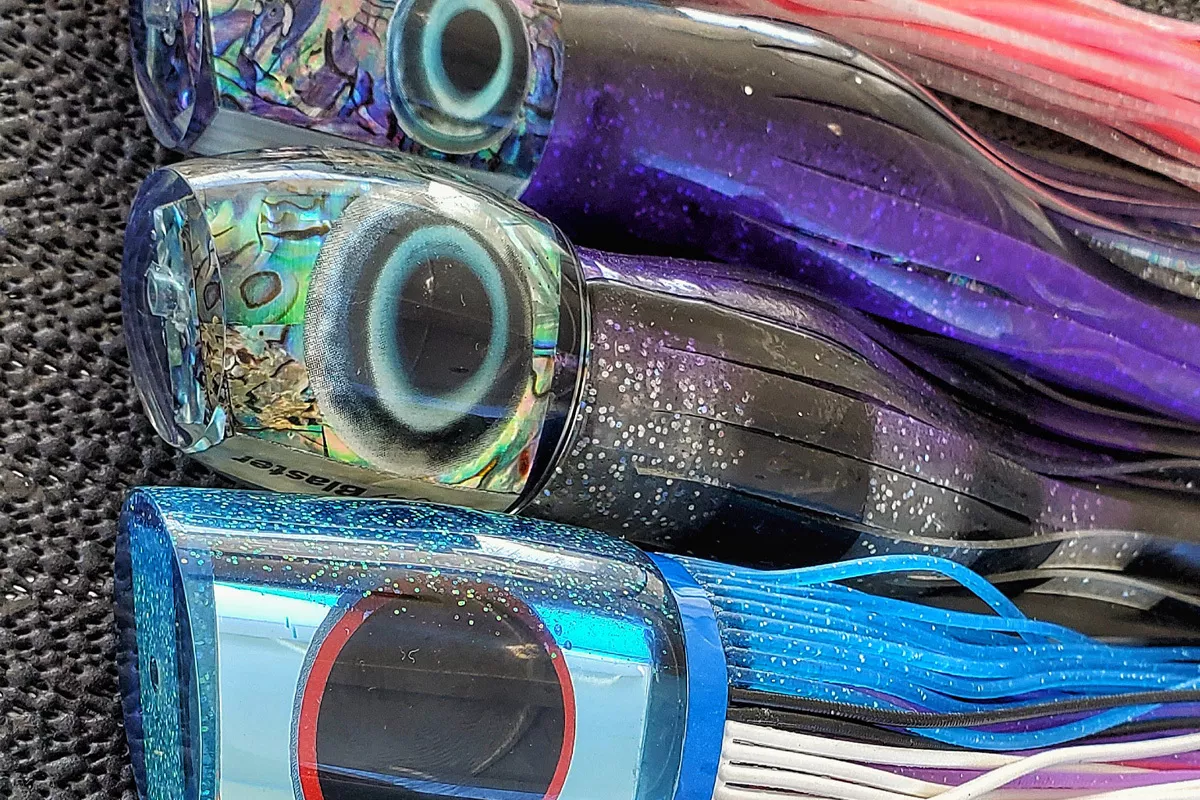
Lures
- Plunger Lures: Plunger lures are known for their tapered, rounded heads, which create a distinctive action in the water. They dive and resurface, creating bubbles and turbulence that attract marlins from a distance.
- Jet Head Lures: These lures have holes in their heads, causing them to spray water and create a bubble trail. This mimics the erratic movement of a distressed fish, a key trigger for the hunting instincts of marlins.
- Poppers and Stickbaits: While less common than skirted lures, poppers and stickbaits can be effective in certain conditions. They create surface commotion that can provoke aggressive strikes from marlin near the surface.
Factors Influencing Lure Selection
- Fishing Location: The local ecosystem dictates the natural prey of marlins in the area. Lures that resemble the local baitfish tend to be more successful.
- Sea Conditions: Calm waters might require different lures compared to choppy conditions. For example, in rough seas, heavier lures that maintain stability and visibility are preferred.
- Time of Day: Light conditions influence lure visibility. Bright, reflective lures are often more effective in full sunlight, while darker silhouettes may work better during dawn, dusk, or overcast conditions.
- Angler's Experience: Experienced anglers might prefer complex lures that offer more control and variability in movement, while beginners might opt for simpler, more straightforward options.
Choosing the right artificial lure for blue marlin fishing is both an art and a science. It requires an understanding of the marlin's behavior, local environmental conditions, and the angler's own skills and preferences. Experimenting with different types of lures and adapting to the conditions at hand is often the key to success in this challenging and rewarding sport.
Ways to Catch Blue Marlin
Blue marlin are powerful and elusive fish, and catching them requires specialized equipment and techniques. Here are some of the more productive ways to catch blue marlin:
- Trolling: Trolling is a common technique used for blue marlin fishing. It involves slowly dragging a lure or bait behind a moving boat, mimicking the movement of a swimming fish. Trolling at high speeds of at least 7 to 10 knots is effective for targeting blue marlin.
- Drift fishing: Drift fishing is another productive way to catch blue marlin. This involves drifting with the current while using live bait or lures, allowing the bait to drift naturally in the water.
- Chunking: While not a widely used technique, chunking involves using chunks of bait, such as tuna or squid, to attract blue marlin to the boat. The chunks are thrown into the water, creating a scent trail that attracts blue marlin.
- Sight fishing: Sight fishing involves spotting blue marlin in the water and casting a lure or bait directly in front of them. This requires careful observation and a quick reaction time, but can be highly effective when done correctly.
- Kite fishing: Kite fishing involves using a kite to suspend a bait or lure in the water, mimicking the movement of a swimming fish. This technique can be highly effective for targeting blue marlin, especially in calm conditions.
Catching blue marlin requires a combination of skill, patience, and specialized equipment. By using the right techniques and equipment, anglers can increase their chances of success and enjoy a thrilling and rewarding fishing experience.
Seth Horne In The Spread, Chief Creator

